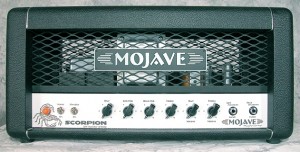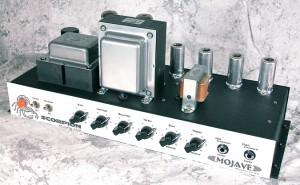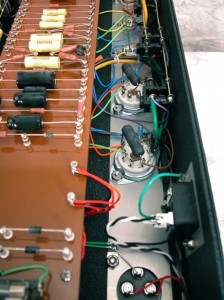Mojave Ampworks impressed us last year with its Peacemaker, a powerhouse of an amp head running EL34s in its power section and providing tones that aim to please a range of rock guitarists. With its 100 watts of output, the Peacemaker was designed for, and best used in, a full-band environment, and preferably those with loud drummers – otherwise consider an attenuator a "must have" device when wanting to get the most out of the Peacemaker.
We were impressed with the raw, strong attack of that amp. It also had a great, distorted hard rock tone. But our review unit WAS brutally loud and you just HAD to run it loud to get that tone.
Now what if you could have an amp that had the same kind of attack and feel of this 100 watter, but have it packaged in a downsized rig of 50 watts? And better still if you could incorporate controls to drive down the overall output volume, but without having to incorporate a master volume circuit or use an attenuator? And the kicker…the tone would remain consistent as the output was brought down.
Those are some ambitious goals. But with the Mojave Ampworks Scorpion 50 watt amplifier head, those were exactly the goals the designers had in mind when they set about to create the amp.
 We at LegendaryTones were definitely intrigued enough about this to ask the Mojave team if they would be interested in having us give it a review. In fairness, I expressed my skepticism against the claims being made and the fact that we would be happy to review the amp, but with a caveat. I stated that we would have a responsibility to bring up and discuss any sonic flaws or issues to readers if the amp didn’t measure up. Victor Mason, one of Mojave Ampwork’s managing partners, remained committed to his claims of the Scorpion’s abilities and generously sent us a test unit to check out.
We at LegendaryTones were definitely intrigued enough about this to ask the Mojave team if they would be interested in having us give it a review. In fairness, I expressed my skepticism against the claims being made and the fact that we would be happy to review the amp, but with a caveat. I stated that we would have a responsibility to bring up and discuss any sonic flaws or issues to readers if the amp didn’t measure up. Victor Mason, one of Mojave Ampwork’s managing partners, remained committed to his claims of the Scorpion’s abilities and generously sent us a test unit to check out.
Features
Mojave’s philosophy in amp design is to not overburden an amp with extra buttons, channels and features that might otherwise interfere with the tonal circuit of the all tube signal path. As a result, the Scorpion remains similar to its larger brother the Peacemaker, and remains as a fairly simple, single-channel design. The Scorpion uses a pair of EL34 tubes and four 12AX7 tubes for its preamp stage. The fourth tube is used for added voltage current gain and not the usual cascading preamp gain design for added buzz.
The front panel has controls for Bass, Low-Mid, Upper-Mid, Treble, and two volume controls that can be blended together: Treble Volume and Bass Volume. High and Low Sensitivity input jacks, On/Off and Standby switches, and power on lamp finish off the front panel. The rear panel includes three output jacks (rather than the use of an impedance selector switch) for running parallel 16-ohm speaker loads, or individual 8 or 16 ohm speaker cabs. A detachable AC power receptacle w/fuse, a direct out jack and a knob labeled "Power Dampening" all round out the features on the back panel.
Power Dampening is the proprietary output volume reduction circuit that Mojave Ampworks devised to bring down the overall output levels of the amp signal. The potentiometer is completely variable and not in set in stepped notches, which means better control of the exact final output desired.
Design and Construction
 The Scorpion has components mounted on a turret board, wired up very cleanly in an all point-to-point fashion. To many amp and tone purists, this style of build is the best method to use even though it is much more labor and time-intensive. It’s how most tube amplifiers were built in the ’50s and ’60s and is virtually non-existent today as far as mass-production name brands are concerned.
The Scorpion has components mounted on a turret board, wired up very cleanly in an all point-to-point fashion. To many amp and tone purists, this style of build is the best method to use even though it is much more labor and time-intensive. It’s how most tube amplifiers were built in the ’50s and ’60s and is virtually non-existent today as far as mass-production name brands are concerned.
The transformers and choke are custom-specified and built Mercury Magnetics units. The output transformer in particular is of interest. It’s a larger unit that would be seen more often in 100 watt models. Victor Mason states that there was more to this integration than simply taking a 100 watt specified output transformer and using it for the Scorpion’s 50 watt design.
All technical challenges aside, the Scorpion chassis is housed in an attractive birch-ply cabinet lined with silver piping and steel cross-patterned vents for the front and back. A nice final cosmetic touch is the fact that the panels themselves on the chassis are laser engraved rather than being silk-screened.
In the Listening Room…
 We used the same configuration of instruments and cabinets with the Scorpion as we used recently with the THD Flexi review. A Gibson Les Paul with Seymour Duncan Antiquity PAFs and a ’69 Fender Custom Shop Stratocaster with stock pickups were the axes of choice. We used two different 4 x 12 Marshall cabinets, one equipped with vintage "pre-Rola" 25 watt G12M "Greenbacks," the other with Celestion G12T-75 watt speakers.
We used the same configuration of instruments and cabinets with the Scorpion as we used recently with the THD Flexi review. A Gibson Les Paul with Seymour Duncan Antiquity PAFs and a ’69 Fender Custom Shop Stratocaster with stock pickups were the axes of choice. We used two different 4 x 12 Marshall cabinets, one equipped with vintage "pre-Rola" 25 watt G12M "Greenbacks," the other with Celestion G12T-75 watt speakers.
When plugging into the high-sensitivity input on the Scorpion and running the Les Paul, Marshall-like gain and compression were the result when I blended and turned up the two volume controls. The Scorpion at 50 watts, puts out a good amount of power and did really retain a lot of the punchier feel that a 100 watt would normally provide. What I’ve always personally enjoyed about 100 watt amps is that when driven hard, they retain a certainly clarity with the notes that is really beneficial when playing harder-driving rock. That quality exists in abundance with the Scorpion I’m happy to report and I suspect that this is due to the larger output transformer that is used.
The other benefit with a 100-watt design is the ability for the amp to clean up the signal when rolling back the volume on a guitar. Because this is a single-channel amp, this feature is rather important, otherwise you could be left with a one-trick pony essentially. The Scorpion cleans up nicely and did so with both guitars, even when running the volume controls up to 7 and 8.
With many non-master volume amps, there’s usually a good "sweet spot" to be found for great crunch and drive and that was at 6 with the Les Paul and 7-8 with the Stratocaster. The voicing of the Scorpion is definitely on the aggressive side, as it has quite a bit of gain and drive on tap as well, so it can definitely do hard rock in addition to classic rock with ease. I found myself playing through the opening riff of Led Zeppelin’s "Heart Breaker" and then going to my ’80s influence of various riffs, most notably Van Halen from the "Fair Warning" era.
You can roll back some of the tone and bring the volume down for nice lighter breakup that’s perfect for bluesy patterns. And in fact, the Power Dampening control on the back of the Scorpion also seems to "ease up" some of the attack that can actually contribute more positively for bluesy tones.
It can be difficult sometimes to describe these features properly, but the best way I could think of to discuss the Power Dampening control when turned down is that it almost feels like a Variac or tube-rectifier circuit was magically added to the design. The tone really does remain true when you use Power Dampening, but the "feel" of the amp does change. This type of sag-response is not only useful for bluesier stylists, but oddly enough, it seems to help for getting the Van Halen type tonal effect of the earlier albums. Now I know Mojave’s Victor Mason is a big early-VH fan himself, so I just imagined the smile that must have been on his face when he played through the Power Dampening circuit for the first time.
Power Dampening to my ears can reduce the dBs to approximately –15. That’s a fairly significant jump in power reduction. It’s not enough to play comfortably in an apartment, but for stage use, it’s more than enough and dampens more than anyone will need. I was pleased to discover that the tone and frequencies of the guitar stayed consistent when using the power dampening circuit. Even at the lowest setting, there was no struggle with the bass notes or "fizz" effect. Definite plus. Overall, the Power Dampening circuit is a great addition. Mojave offers this feature as an upgrade to its other amplifiers as well, for those that may already own an amp, but wish to add some added flexibility.
As I experimented and achieved nice sonic results through all guitars and both speaker cabinets, it was very clear that the Mojave team are not only good design engineers, but they also have a good ear for tone as well. In fact, their good ears are probably why I didn’t even mind the one downside I felt the Scorpion had. Essentially, I wish the e.q. controls had a bit more sweep and usability to them. But because the amp is sonically set up for good tone from the get go, it doesn’t really need much to tweak it anyway and those that love to just "plug in and go" will probably like the fact that the tone controls aren’t so sensitive.
Final Thoughts
The Scorpion is certainly my favorite Mojave Ampworks design to date. Its combination of great design, tone, and versatility of the Power Dampening circuit, together make this a great all-around rock or blues amp.
If you’re a player who has already used or currently use an "old school" single-channel vintage amp and have experience driving them to their limits, I can say with confidence that you will be right at home with the Scorpion. On that note, it should be said that the Scorpion shares an influence that is most closely linked to the early great Marshall Lead and Super Lead models. Those sounds are all inside the Scorpion. In fact, the Scorpion sounds as good and most often better than virtually all of the Marshall 50 watt amps that I’ve ever owned or played in the past. And as your resident Marshall and vintage-amp nut, I can say that I’ve gone through quite a few. The Scorpion isn’t a mere Marshall clone and is voiced a little bit differently with its e.q., but it’s really user friendly and just feels right and puts you into similar territory. Ultimately, the Scorpion is a great way to transition to a nice 50-watt amp that is hand built and available new today, without inheriting the challenges or maintenance uncertainties that can be present when owning a vintage amp.